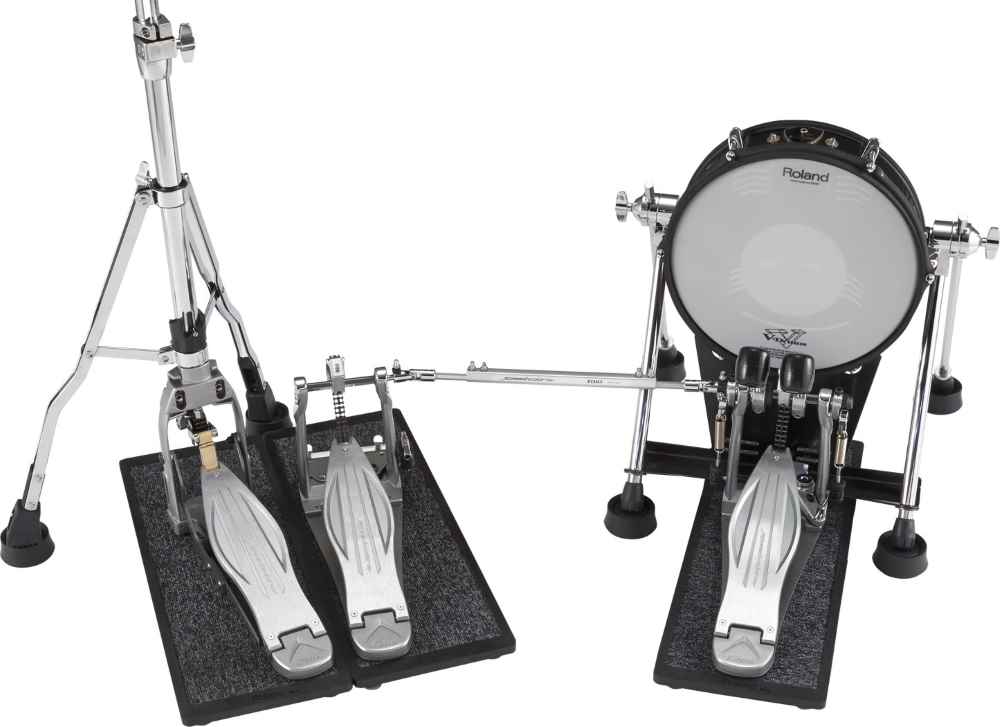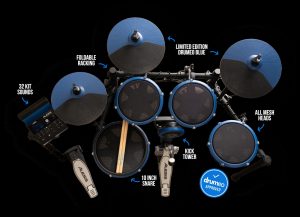While eDrums are quieter than acoustics, eDrums can still create impact noise. This can be improved with Roland Noise Eaters. Unfortunately, they’re expensive, and there are few options on the market that offer a similar solution to making your eDrums quieter. If you’re willing to go the DIY route, here are three options to consider.
What are Roland Noise Eaters?
Roland Noise eaters are sound isolation boards for use with kick pads and pedals and hi-hat stands which isolate the pedals from the floor. This is done using multiple dome-shaped rubber dampers, to reduce the transfer of the vibrations and thudding into the floor that is typically experienced when playing the drums.

Noise Eaters are great for apartment drummers or drummers with their kit on an upper floor and can have a significant impact on reducing the sound of the drums for occupants below. That’s because the impact nose transmitted through the floor creates the bulk of the overall sound coming from playing an eDrum kit.
Related: Our pick of the best double pedals for eDrums
What alternatives are there to the Roland NE-10 Noise Eater?
There aren’t any other products like the NE-10 Noise Eater on the market, unfortunately. But that doesn’t mean you’re out of options when it comes to making your electronic drums quieter. The alternatives listed below are all DIY, but as a result, cost a fraction of the NE-10 Noise Eater.
1. Tennis Ball Riser
The tennis ball riser is probably the most well-known way to reduce volume among eDrummers. A tennis ball riser is essentially a large platform, typically made from MDF, which the electronic drum kit, and sometimes even the player, is mounted on. This platform is supported on a bed of tennis balls (usually cut in half), which isolate vibrations between the platform and the floor below.
However, a tennis ball riser is a large piece of equipment and can be daunting to build if you’re not confident at DIY. A lot of weight needs to be supported on top of the riser, which means the platform often needs to consist of a rigid frame plus a floor to support the weight.
The result of the large size means a relatively high cost and risk of getting it wrong if you build a platform that can’t support the correct weight. Some other practical downsides may emerge, for example, if you build a platform for the drums themselves but not the player, you’ll need to have a drum stool that is tall enough for the extra height that your pedals and drums will be at relative to your drum stool.
The cost involved may mean shelling out for an official set of Roland Noise Eaters is not much more, with less hassle and no DIY required.
Alternatively, we have two other options to consider.
2. DIY Noise Eaters – Sylomer Pads
It is possible to build your own DIY Noise Eaters, which you can do by following our DIY Noise Eater guide. Our method makes use of sylomer pads, which are used in various applications, from isolating vibrations beneath industrial machinery and railway tracks to isolating speaker cabinets to improve sound quality. It’s the latter where we source small sylomer pads for our DIY noise eater build, using small Sylomer pucks designed for speakers.
The process is relatively simple – create a platform for both the hi-hat stand and bass drum trigger, then mount this on top of a set of sylomer pads (we used sylomer pads). Some experimentation may be required to determine the right number of pucks for the weight of the bass drum and hi-hat. That’s because Sylomer pads require a specific window of pressure to be able to effectively reduce vibrations.
However, the cost is low – our DIY noise eaters using sylomer cost £57 to build, vs £365 for a set of Roland Noise Eaters.

3. DIY Noise Eaters – Tennis balls
Another way to build a DIY Roland Noise Eater is to apply the tennis ball method to a smaller platform. This is a good option if you cannot get your hands on sylomer pucks, which can be hard to find.
One possible downside of this approach is that each platform is slightly higher than when using the Sylomer pad method – even if you cut the tennis balls in half. Cutting the tennis balls can be difficult too, and you might find the cut isn’t 100% straight if you’re not careful.
That said, you can follow a guide to creating your own via this Youtube video by Demonic Sweaters:
4. Quiet bass drum pedals
Another cheap option you might hear about is to use a practice bass drum beater, such as the Roland KDB-200. This particular pedal is marketed as a noise-reduction beater for practice use. The foam head is designed to reduce impact and rebound noise on mesh drum heads and kick towers, while also being safe for use on acoustic drums.
I have a pair of these KDB-200 kick drum pedals, and if your aim is to reduce noise, be warned – the impact is minimal. These beaters have a minimal impact on sound reduction because they do not reduce the impact noise transmitted through the floor when you play your electronic drums.
A much better solution is to go with a Roland Noise Eater, or one of the DIY alternatives noted above.
Is the Roland Noise Eater the best way to make your eDrums quieter?
As it stands, the Roland Noise Eater is the only product on the market that allows drummers to reduce the impact sound made by their electronic drums. However, the DIY options can be significantly cheaper, and our recommendation is to try the sylomer pad DIY noise eaters first. The cost-saving vs official Roland Noise Eaters is significant, and this method is easy to do using only basic tools and minimal DIY experience.
If you are confident at DIY, then you may want to consider building a tennis ball riser. However, it is worth costing up this build, you may find it is close to or the same as purchasing a set of Roland Noise Eaters. If this is the case, then our recommendation is to try the Roland approach, since if you’re not satisfied with the results, you can always take them back for a refund.
Finally, if you’re unable to find sylomer pads, then building a DIY noise eater using tennis balls is an option, however, one that we cannot vouch for at eDrumHub, as it’s not something we’ve tested specifically.
This article contains affiliate links. If you purchase a product through certain links on our site, we may earn a small affiliate commission. Learn more about our adverts and why you can trust eDrumHub here.





2 replies on “4 Cheaper Alternatives to Roland Noise Eaters”
The tennis ball solution is really weak. The idea is fine just that tennis balls are a bad insulator. Auralex Platafoam, Sorbethane pucks, or other dense foams or rubber are better. Also many of the home made drum decks make a big mistake that hinders the vibration absorption, which is to put the throne on the deck. This adds your weight to the platform which compresses the springs (whatever they are) making them much less effective.
My deck consists of two 3′ x 4′ pieces of 3/4″ ply. Works great. Having the throne on the floor does mean you may need a new throne if you sit high, but the platform will work much much better.
https://billwolf.com/temp/drum%20platform%20006.JPG
Thanks for sharing Bill! It seems the tennis ball method is the most widely talked about on Youtube, Reddit and other drum forums, so it’s good to hear about lesser known alternatives. Good point about considering drum throne height too! I definitely think taking the throne out of the equation massively simplifies things for anyone looking to build a platform.